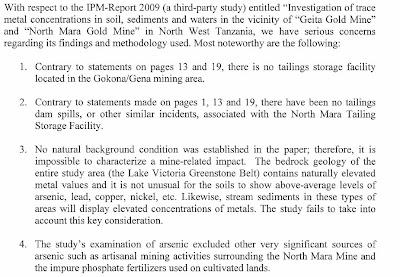Baada ya kulivalia njuga hili suala nazidi kupata taarifa zaidi kila kukicha. Na mimi sisiti kuwapa taarifa Watanzania wenzangu na watu wengine wanaolifuatilia hili jambo kwa makini. Nakala hii ya uchunguzi wa kina inapatikana kwenye websites za Business & Human Rights na Africa Files. Na inaangalia mazingira ya sehemu mbili – migodi ya Geita na Mara.
Ingawa ripoti inamalizia kwa kuomba kufanyika uchunguzi zaidi, hasa kuangalia afya za waathirika, kuna dalili kuwa hili suala litafika kwenye vyombo husika vitakavyoweza kutusaidia Watanzania.
___________________________________________________________________
Investigations of trace metal concentrations in soil, sediments and waters in the vicinity of ”Geita Gold Mine” and ”North Mara Gold Mine” in North West Tanzania
The study was conducted by The Norwegian University of Life Sciences in cooperation with the University of Dar es Salaam. Researchers were Åsgeir R. Almås, Charles Kweyunga and Mkwabwa LK Manoko. It was commissioned by the Tanzania Episcopal Conference (TEC), Bakwata, and the Christian Council of Tanzania (CCT). The results are based on sampling of water, soil and sediments. Samples were taken at 36 different sites around the Geita Gold mine, North Mara Gold mine and control locations. A total of 100 soil and sediment samples and 36 water samples were taken. The samples were analyzed at the University of Life Sciences Norway.
The purpose of the study was to investigate the environmental impact of the mining activity in Geita and North Mara.
Key findings:
North Mara Gold Mine (Barrick Gold)
The mine is situated in the Mara-district east of Victoria Lake in North Tanzania. The closest town is Tarime.
The environmental situation in North Mara is very worrying. For a while people have claimed that the tailing dam is leaking and so fear contamination of the area. Barrick has alleged that people have been stealing the lining of the tailing dam and destroying pipes. The area surrounding the tailing dam is not fenced. In May 2009 a major spill occurred at the mine. Samples were taken both the area of the spill and the tailing dam at various distances.
The study finds extremely high levels of arsenic, cadmium, cobalt, copper, crom, nickel and zinc at the area around the spill. The environment has been seriously contaminated. The arsenic (As) content in the most contaminated water sample were one to two orders of magnitude higher than the WHO drinking water guidelines (10 µg/l). The most extreme water sample contained 8449 µg/l, which is about half a lethal dose of arsenic for a human. Currently, the WHO guideline for maximum As concentration in drinking water is 10 µg/l, but this standard is set to be lowered to 5 µg/l in the near future. This site is currently not being used by the population, but is accessible and represents a very real danger. Also, the extreme levels of dangerous substances found at the site show how toxic the material handled by the mine is and the danger that accidental spills represent.
There are also extreme concentrations of arsenic around the tailing dam itself. Concentrations of arsenic ranging from 1142 to 111 µg/l were found in water samples. One area used for grazing by cattle contained 413 µg/l of arsenic. A nearby area regarded as safe by the population and used for drinking water contained 8 µg/l of arsenic – just below current WHO-standards.
This area also contained high levels of cobalt up to 319 µg/l. WHO has no guidelines for dangerous levels of cobalt in drinking water. The proposed Canadian guidelines for aquatic life state that the level should not exceed 4 µg/l for chronic exposure and 110 µg/l for acute toxicity. In other words aquatic life starts dying above 110 µg/l.
Samples from the soil also show high levels of arsenic at the spill site and higher than normal levels of other minerals. Sediments (top layer) also showed high and very high levels of arsenic. All other metals also have elevated levels compared to the control sample taken well away from the mine. It is therefore clear that the mine is having a sustained impact on the surrounding environment in North Mara.
The study does not speculate on possible reasons for this contamination in North Mara. However, one likely reason is that the tailing dam is leaking.
When dug the earth in this area seems to be saturated with water. The company has placed pumps at various places to pump water back into the tailing dam. Another possible reason is leeching from the rock deposited in the landscape.
Geita Gold Mine (Anglo Gold Ashanti)
In Geita the situation is less acute. The study finds higher levels of arsenic and other metals in sediments compared to natural levels. Water samples were all within WHO drinking standards with the exception of one site in a restricted area. Still, the higher levels measured in sediments is worrying and probably means that pollution has occurred in the past through flooding. When measuring water you are getting a picture of the situation at that moment. Finding arsenic in sediments at various sites is of concern even if the concentration in water bodies were not very high.
Cyanide
Cyanide was not found to be a problem in Geita or North Mara at the time of the study. This could be due to the fact that cyanide quickly bonds with other substances turning into harmless compounds. It is therefore very difficult to measure the level of cyanide in water unless the measurements are taken at the time of a spill.
Consequences
There are many serious health effects resulting from exposure to arsenic. A variety of cancers, birth defects and numerous skin problems are among the effects. People with skin problems consistent with arsenic poisoning can be found both in Geita and North Mara. More research is needed through taking hair, nails and urine samples to confirm that arsenic is the problem.
In North Mara the area where the spill took place is toxic and dangerous for people and cattle – it is a disaster site. The area around the tailing dam and in effect between the two rivers Tighite and Mara might become contaminated and harmful to people unless the contamination caused by the tailing dam is stopped.
And here is the Barrick’s response:
___________________________________________________________________
Kwa mtazamo wangu nadhani taarifa kutoka Barrick zinakinzana kidogo na majibu yao hayajaniridhisha. Kumbuka, hawa hawa ndio waliokuwa wanadai wanavijiji ndio wa kulaumiwa; kwa kuiba vizuizi kwenye bwawa la takataka la mgodi. Napenda kurudia, haya yangeweza kuzuilika. Na tuna uhakika kuwa hawa waliofanya huu uchunguzi hawakuruhusiwa kuingia kwenye mgodi!
Kama wachangiaji kadhaa walivyosema kwenye makala zilizopita shughuli hii ni pevu. Kwahiyo tunahitaji umoja na mshikamano. Kama unaweza kusaidia kwa njia yoyote ile, usisite kuwasiliana nasi au Foundation HELP (info@foundationhelp.org); iwe kwa kututumia taarifa unazodhani zitasaidia (kutoka kwenye Wizara ya Nishati na Madini au Barrick Mara).
Natanguliza shukrani za dhati!



